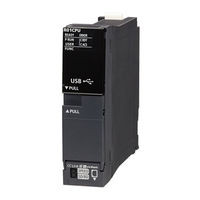Mitsubishi Electric MELSEC iQ-R-R32ENCPU Manuals
Manuals and User Guides for Mitsubishi Electric MELSEC iQ-R-R32ENCPU. We have 1 Mitsubishi Electric MELSEC iQ-R-R32ENCPU manual available for free PDF download: User Manual
Mitsubishi Electric MELSEC iQ-R-R32ENCPU User Manual (1028 pages)
MELSEC iQ-R series CPU Module Application User's Manual
Brand: Mitsubishi Electric
|
Category: Controller
|
Size: 31 MB
Table of Contents
-
Introduction18
-
Terms36
-
Scan Time
42 -
Program Flow
54 -
-
Data Memory100
-
Function Memory100
-
Refresh Memory100
-
SD Memory Card101
-
Memory Operation
103 -
Files
104 -
Part 2 Functions
109 -
Time Setting
110 -
System Clock
116 -
Online Change
117 -
Precautions
122 -
Error Clear
135 -
Remote RUN/STOP
143-
Executing Method143
-
Precautions144
-
-
Remote PAUSE
144-
Executing Method144
-
-
Remote RESET
145 -
Precautions
149 -
-
Data Type173
-
-
Each Scan175
-
-
Logging Type
180 -
-
LED Status187
-
Missing Data
195 -
Auto Logging
206 -
-
Object Data224
-
Memory Dump File228
-
-
Specifications
235 -
Backup Function
272 -
-
Stop Setting293
-
Clock Data297
-
-
-
Execution Timing319
-
Precautions319
-
-
Setting Method
328 -
Setting Example
329 -
Precautions
329 -
Device List
332 -
Device Setting
333 -
User Device
335-
Input (X)335
-
Output (Y)335
-
Latch Relay (L)336
-
Link Relay (B)336
-
Annunciator (F)336
-
Edge Relay (V)339
-
Step Relay (S)339
-
Timer340
-
Counter346
-
-
System Device
350 -
-
Precautions354
-
-
Nesting (N)
362 -
Pointer (P)
363-
Global Pointer363
-
Local Pointer364
-
Pointer Setting365
-
-
Global Device
368 -
Local Device
368 -
Global Labels
374 -
Local Labels
374 -
Classes
375 -
Data Types
376 -
Arrays
379 -
Structures
383 -
Precautions
387 -
-
Usage Procedure396
-
Precautions398
-
-
Precautions
402 -
System
408 -
Overview
424 -
Wiring
430 -
-
Precautions442
-
System Switching
443 -
-
File479
-
Operating Status480
-
SD Memory Card480
-
-
Constant Scan
490 -
Online Change
491 -
RAS Function
492 -
Remote Operation
493 -
Boot Operation
495 -
-
Overview
526 -
Safety Program
527 -
-
Setting Method529
-
-
Memory Operation
532 -
Files
533 -
-
Output Settings551
-
Auto Logging551
-
RAS Functions
552-
Error Clear553
-
Safety Devices
556 -
Safety Label
561-
Classes563
-
Data Types564
-
Structures564
-
Constants
564 -
System
567 -
-
Overview581
-
Safety Program582
-
-
-
Memory Operation587
-
Files588
-
Process Cpu592
-
-
Overview
592 -
Wiring
599 -
System Switching
611 -
-
File646
-
Operating Status647
-
SD Memory Card648
-
-
Online Change
664 -
Constant Scan
664 -
Remote Operation
665 -
RAS Functions
671 -
Safety Devices
677 -
Safety Label
683-
Classes685
-
Data Types686
-
Structures686
-
Constants
686 -
-
-
Process Cpu699
-
-
Appendices
703 -
-
Event List792
-
-
-
SFC Information810
-
System Clock812
-
Latch Area821
-
-
SFC Information852
-
Latch Area862
-
-
System Clock885
-
-
-
CPU Parameters937
-
-
-
Precautions946
-
-
-
Data Operation1000
-
Clause1002
-
Aggregate Function1004
-
Arithmetic Function1005
-
-
-
Index1015
-
Revisions1019
-
Warranty1021
-
Trademarks1026
-
Advertisement
Advertisement
Related Products
- Mitsubishi Electric MELSEC iQ-R-R32CPU
- Mitsubishi Electric MELSEC iQ-R-R32PCPU
- Mitsubishi Electric MELSEC iQ-R-R32PSFCPU
- Mitsubishi Electric MELSEC iQ-R-R32SFCPU
- Mitsubishi Electric MELSEC iQ-R-R01CPU
- Mitsubishi Electric MELSEC iQ-R-R08SFCPU
- Mitsubishi Electric MELSEC iQ-R-R6RFM
- Mitsubishi Electric MELSEC iQ-R-R120SFCPU
- Mitsubishi Electric MELSEC iQ-R-R6SFM
- Mitsubishi Electric MELSEC iQ-R-R120ENCPU
